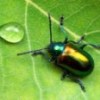Let me preface this post by saying that Christian Peeters is one of my absolute favorite myrmecologists. If lost in a remote African jungle and stalked by ravenous leopards, for example, Christian is the first ant guy I'd pick to help get me out of the predicament.
Having said that, this paper in Insectes Sociaux is so bad I nearly gouged my eyes out and ran around in little circles screaming and flailing my arms.
Nonetheless there exist extant ants with relatively simple societies, where size-polymorphic workers and large queens are absent. Recent phylogenies show that the poneroid subfamilies Amblyoponinae and Ponerinae are basal (e.g. Brady et al., 2006), i.e. closer to solitary vespoid wasps.
Ten points to the first person who can explain what's wrong with it.

Is it that members of basal ant groups may not nest in places that are particularly close to solitary wasps? Do I get the points? Do I?
You should do a series called "The Myrmecos Guide to Interpreting the Phylogeny of the Ants" or link to some good tree-reading sources.
Here is a good paper about inappropriate uses of basality: Krell and Cranston. Which side of the tree is more basal?. Systematic Entomology (2004) vol. 29 (3) pp. 279-281
Yeah, Scott, only apical ants nest close to apical, social wasps.
Is it because the relationship of the older lineages of ants,i.e. the 5 poneroid subfamilies (Ponerinae, Amblyoponinae, Paraponerinae, Proceratiinae, and Agroecomyrmecinae), the Leptanillinae, and Martialinae, to one another and the formicoids is unknown?
As ants clearly are a monophyletic group, all ants are closer to other ants than to non-formicid hymenoptera.
Gunnar beat me to it. But yeah, how the hell is an -ant- species (which seem to be monophyletic, right?), regardless of its 'basality' or whatever, suddenly CLOSER to a completely outside group?!
PHYLOGENY - UR DOIN IT WRONG
Oh my FSM, this is an ACTUAL PEER REVIEWED ARTICLE? Writing papers seems easier than undergrad finals sometimes... ok, maybe just writing crap papers with glaring errors, but still...
Is it acceptable to say "basal with respect to [blah]"?
Grumble grumble. Although I've made the Krell & Cranston mistake myself in terms of word usage (i.e. the basal clade is just at the base of the tree because the other taxa were more closely related and the tree looked weird flipped the other way--before I knew better, of course) I never misinterpreted the meaning this badly. I get equally curmudgeonly when I hear people talking about "this species is more evolved than this species" which you see mostly in the popular lit, but it still makes me cringe.
oh Psi, no in the strictest terms it's not ok to say "basal with respect to", unless you've sampled an extinct taxon that existed along the branch connecting your root to your contemporary taxa. You should say "Clade A is sister to Clade B".
I'm sure I must be missing something, but I would have thought that ants and social vespids were closer.
Re basal (presumably refers to a branching pattern - and I know nothing about ants), primitive, and the like - there are lots of tricky words with more cultural baggage than science.